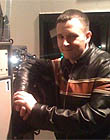|
Author
|
Topic: MicroSoft Illumiroom
|
|
|
|
|
|
|
|
|
|
|
|
|
|
|
|
|
|
|
|
|
|
|
|
|
|
|
|
|
Randy Stankey
Film God

Posts: 6539
From: Erie, Pennsylvania
Registered: Jun 99
|
 posted 05-09-2013 11:23 PM
posted 05-09-2013 11:23 PM




Perkinje images have been known since the 1800's.
http://en.wikipedia.org/wiki/Purkinje_images
Think for a sec. Gaze tracking depends, not only on detecting the rotation of the eyeball, but on detecting position of the head, too.
Hold a finger up, in front of your face, look at it and keep your gaze fixed on it. Move your finger around and your eyes will rotate to follow. Now, keep your finger still and turn your head. Your head AND your eyes move. Without knowing the position of both the head and the eyes, gaze tracking is virtually impossible. Therefore, you need two tracking devices. One for the head and one for the eye.
The head tracking device would likely be a helmet with position sensors built into it. The eye tracking device would probably have to be affixed to the head tracking device because its measurements are relative to the head's measurements.
Bottom line, you would probably know if your vision is being tracked because you would have to wear some kind of headgear or some deivce would have to be attached directly to your head.
In either case, not suitable for "stealth" use.
| IP: Logged
|
|

 Home
Home
 Products
Products
 Store
Store
 Forum
Forum
 Warehouse
Warehouse
 Contact Us
Contact Us




 Printer-friendly view of this topic
Printer-friendly view of this topic















